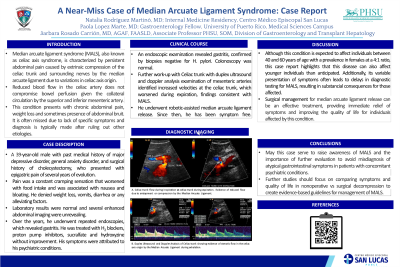Sunday Poster Session
Category: Stomach
P1696 - A Near-Miss Case of Median Arcuate Ligament Syndrome: Case Report
Sunday, October 27, 2024
3:30 PM - 7:00 PM ET
Location: Exhibit Hall E

Has Audio

Natalia Rodriguez-Martino, MD
Saint Luke's Hospital
San Juan, PR
Presenting Author(s)
Natalia Rodriguez-Martino, MD1, Paola Lopez-Marte, MD2, Barbara Rosado-Carrion, MD3
1Saint Luke's Hospital, San Juan, Puerto Rico; 2University of Puerto Rico, Medical Sciences Campus, San Juan, Puerto Rico; 3Ponce Health Sciences University, San Juan, Puerto Rico
Introduction: Median arcuate ligament syndrome (MALS), also known as celiac axis syndrome, is characterized by persistent abdominal pain caused by extrinsic compression of the celiac trunk and surrounding nerves by the median arcuate ligament due to variations in celiac axis origin. Reduced blood flow in the celiac artery does not compromise bowel perfusion given the collateral circulation by the superior and inferior mesenteric artery. This condition presents with chronic abdominal pain, weight loss and sometimes presence of abdominal bruit. It is often missed due to lack of specific symptoms and diagnosis is typically made after ruling out other etiologies.
Case Description/Methods: A 39-year-old male with medical history of major depressive disorder, general anxiety disorder, and surgical history of cholecystectomy, who presented with epigastric pain of several years of evolution. Pain was a constant cramping sensation that worsened with food intake and was associated with nausea and bloating. He denied weight loss, vomits, diarrhea or any alleviating factors. Laboratory results were normal and several enhanced abdominal imaging were unrevealing. Over the years, he underwent cholecystectomy due to symptomatic cholecystitis and repeated endoscopies, which revealed gastritis. He was treated with H2 blockers, proton pump inhibitors, sucralfate and hydroxyzine without improvement. His symptoms were attributed to his psychiatric conditions. After several years of persistent abdominal pain, he sought further evaluation by a gastroenterologist. An endoscopic examination revealed gastritis, confirmed by biopsies negative for H. pylori. Colonoscopy was normal. Further work-up with duplex examination of mesenteric arteries identified increased velocities at the celiac trunk, which worsened during expiration, findings consistent with MALS. He underwent robotic-assisted median arcuate ligament release. Since then, he has been symptom free.
Discussion: MALS is more common in females than in males, with a 4:1 ratio, and presents more frequently in individuals aged 40 to 60-years. This case raises awareness of MALS and the importance of further evaluation to avoid misdiagnosis of atypical gastrointestinal symptoms in patients with concomitant psychiatric conditions. Median arcuate ligament release can be an effective treatment, providing immediate relief of symptoms and improving the quality of life for individuals affected by this condition.
Disclosures:
Natalia Rodriguez-Martino, MD1, Paola Lopez-Marte, MD2, Barbara Rosado-Carrion, MD3. P1696 - A Near-Miss Case of Median Arcuate Ligament Syndrome: Case Report, ACG 2024 Annual Scientific Meeting Abstracts. Philadelphia, PA: American College of Gastroenterology.
1Saint Luke's Hospital, San Juan, Puerto Rico; 2University of Puerto Rico, Medical Sciences Campus, San Juan, Puerto Rico; 3Ponce Health Sciences University, San Juan, Puerto Rico
Introduction: Median arcuate ligament syndrome (MALS), also known as celiac axis syndrome, is characterized by persistent abdominal pain caused by extrinsic compression of the celiac trunk and surrounding nerves by the median arcuate ligament due to variations in celiac axis origin. Reduced blood flow in the celiac artery does not compromise bowel perfusion given the collateral circulation by the superior and inferior mesenteric artery. This condition presents with chronic abdominal pain, weight loss and sometimes presence of abdominal bruit. It is often missed due to lack of specific symptoms and diagnosis is typically made after ruling out other etiologies.
Case Description/Methods: A 39-year-old male with medical history of major depressive disorder, general anxiety disorder, and surgical history of cholecystectomy, who presented with epigastric pain of several years of evolution. Pain was a constant cramping sensation that worsened with food intake and was associated with nausea and bloating. He denied weight loss, vomits, diarrhea or any alleviating factors. Laboratory results were normal and several enhanced abdominal imaging were unrevealing. Over the years, he underwent cholecystectomy due to symptomatic cholecystitis and repeated endoscopies, which revealed gastritis. He was treated with H2 blockers, proton pump inhibitors, sucralfate and hydroxyzine without improvement. His symptoms were attributed to his psychiatric conditions. After several years of persistent abdominal pain, he sought further evaluation by a gastroenterologist. An endoscopic examination revealed gastritis, confirmed by biopsies negative for H. pylori. Colonoscopy was normal. Further work-up with duplex examination of mesenteric arteries identified increased velocities at the celiac trunk, which worsened during expiration, findings consistent with MALS. He underwent robotic-assisted median arcuate ligament release. Since then, he has been symptom free.
Discussion: MALS is more common in females than in males, with a 4:1 ratio, and presents more frequently in individuals aged 40 to 60-years. This case raises awareness of MALS and the importance of further evaluation to avoid misdiagnosis of atypical gastrointestinal symptoms in patients with concomitant psychiatric conditions. Median arcuate ligament release can be an effective treatment, providing immediate relief of symptoms and improving the quality of life for individuals affected by this condition.
Disclosures:
Natalia Rodriguez-Martino indicated no relevant financial relationships.
Paola Lopez-Marte indicated no relevant financial relationships.
Barbara Rosado-Carrion indicated no relevant financial relationships.
Natalia Rodriguez-Martino, MD1, Paola Lopez-Marte, MD2, Barbara Rosado-Carrion, MD3. P1696 - A Near-Miss Case of Median Arcuate Ligament Syndrome: Case Report, ACG 2024 Annual Scientific Meeting Abstracts. Philadelphia, PA: American College of Gastroenterology.
